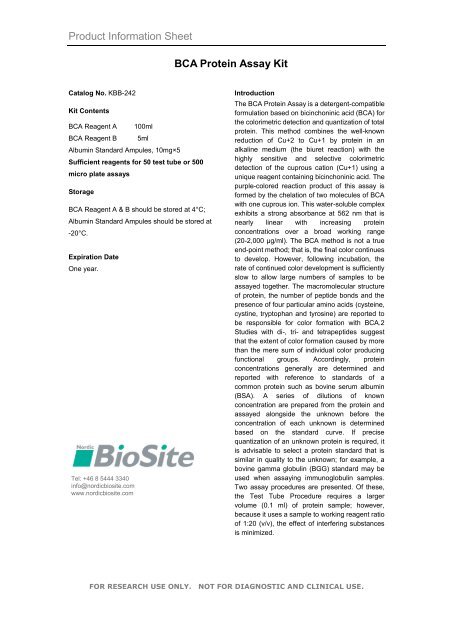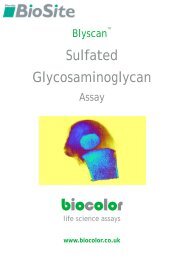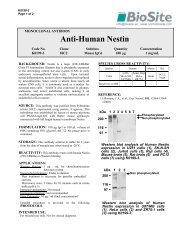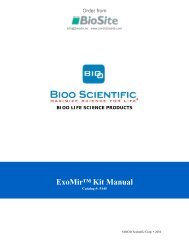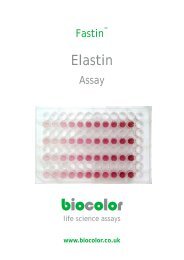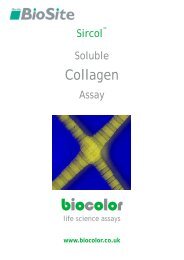Product Information Sheet BCA Protein Assay Kit - Nordic Biosite
Product Information Sheet BCA Protein Assay Kit - Nordic Biosite
Product Information Sheet BCA Protein Assay Kit - Nordic Biosite
You also want an ePaper? Increase the reach of your titles
YUMPU automatically turns print PDFs into web optimized ePapers that Google loves.
<strong>Product</strong> <strong>Information</strong> <strong>Sheet</strong><br />
<strong>BCA</strong> <strong>Protein</strong> <strong>Assay</strong> <strong>Kit</strong><br />
Catalog No. KBB-242<br />
<strong>Kit</strong> Contents<br />
<strong>BCA</strong> Reagent A<br />
<strong>BCA</strong> Reagent B<br />
100ml<br />
5ml<br />
Albumin Standard Ampules, 10mg×5<br />
Sufficient reagents for 50 test tube or 500<br />
micro plate assays<br />
Storage<br />
<strong>BCA</strong> Reagent A & B should be stored at 4°C;<br />
Albumin Standard Ampules should be stored at<br />
-20°C.<br />
Expiration Date<br />
One year.<br />
Tel: +46 8 5444 3340<br />
info@nordicbiosite.com<br />
www.nordicbiosite.com<br />
Introduction<br />
The <strong>BCA</strong> <strong>Protein</strong> <strong>Assay</strong> is a detergent-compatible<br />
formulation based on bicinchoninic acid (<strong>BCA</strong>) for<br />
the colorimetric detection and quantization of total<br />
protein. This method combines the well-known<br />
reduction of Cu+2 to Cu+1 by protein in an<br />
alkaline medium (the biuret reaction) with the<br />
highly sensitive and selective colorimetric<br />
detection of the cuprous cation (Cu+1) using a<br />
unique reagent containing bicinchoninic acid. The<br />
purple-colored reaction product of this assay is<br />
formed by the chelation of two molecules of <strong>BCA</strong><br />
with one cuprous ion. This water-soluble complex<br />
exhibits a strong absorbance at 562 nm that is<br />
nearly linear with increasing protein<br />
concentrations over a broad working range<br />
(20-2,000 μg/ml). The <strong>BCA</strong> method is not a true<br />
end-point method; that is, the final color continues<br />
to develop. However, following incubation, the<br />
rate of continued color development is sufficiently<br />
slow to allow large numbers of samples to be<br />
assayed together. The macromolecular structure<br />
of protein, the number of peptide bonds and the<br />
presence of four particular amino acids (cysteine,<br />
cystine, tryptophan and tyrosine) are reported to<br />
be responsible for color formation with <strong>BCA</strong>.2<br />
Studies with di-, tri- and tetrapeptides suggest<br />
that the extent of color formation caused by more<br />
than the mere sum of individual color producing<br />
functional groups. Accordingly, protein<br />
concentrations generally are determined and<br />
reported with reference to standards of a<br />
common protein such as bovine serum albumin<br />
(BSA). A series of dilutions of known<br />
concentration are prepared from the protein and<br />
assayed alongside the unknown before the<br />
concentration of each unknown is determined<br />
based on the standard curve. If precise<br />
quantization of an unknown protein is required, it<br />
is advisable to select a protein standard that is<br />
similar in quality to the unknown; for example, a<br />
bovine gamma globulin (BGG) standard may be<br />
used when assaying immunoglobulin samples.<br />
Two assay procedures are presented. Of these,<br />
the Test Tube Procedure requires a larger<br />
volume (0.1 ml) of protein sample; however,<br />
because it uses a sample to working reagent ratio<br />
of 1:20 (v/v), the effect of interfering substances<br />
is minimized.<br />
FOR RESEARCH USE ONLY. NOT FOR DIAGNOSTIC AND CLINICAL USE.
Protocol<br />
Preparation of Standards and Working Reagent (required for both assay procedures)<br />
A. Preparation of Diluted Albumin (BSA) Standards<br />
Use Table 1 as a guide to prepare a set of protein standards.<br />
Table 1. Preparation of Diluted Albumin (BSA) Standards<br />
1. <strong>BCA</strong> Regent A to <strong>BCA</strong> Regent B ratio = 50:1 (i.e. Add 1ml <strong>BCA</strong> Reagent B into 50ml <strong>BCA</strong><br />
Reagent A).<br />
2.Dilution Scheme for Standard Test Tube Protocol and Microplate Procedure (Working<br />
Range = 25–2,000μg/ml) (Dilute the lyophilized Albumin Standard Ampules with 0.9% NaCl or PBS<br />
to 2,000μg/ml working solution )<br />
Volume of Volume and Final<br />
BSA<br />
Tube<br />
Diluent<br />
Source of BSA Concentration<br />
A 0ul 600ul 2000ug/ml<br />
B 100ul 300ul 1500ug/ml<br />
C 300ul 300ul of A dilution 1000ug/ml<br />
D 200ul 200ul of B dilution 750ug/ml<br />
E 300ul 300ul of C dilution 500ug/ml<br />
F 300ul 300ul of E dilution 250ug/ml<br />
G 300ul 300ul of F dilution 125ug/ml<br />
H 400ul 100ul of G dilution 25ug/ml<br />
I 300ul 0ul 0ug/ml(blank)<br />
• Test Tube Procedure (Sample to WR ratio = 1:20)<br />
1. Pipette 0.1 ml of each standard and unknown sample replicate into an appropriately labeled<br />
test tube.<br />
2. Add 2.0 ml of the WR to each tube and mix well.<br />
3. Cover and incubate tubes at selected temperature and time:<br />
a. Standard Protocol: 37°C for 30 minutes (working range = 25-2,000 μg/ml)<br />
b. RT Protocol: RT for 2 hours (working range = 25-2,000 μg/ml)<br />
c. Enhanced Protocol: 60°C for 30 minutes (working range = 5-250 μg/ml)<br />
Notes:<br />
Increasing the incubation time and temperature can increase the net 562 nm absorbance for<br />
each test and decreases both the minimum detection level of the reagent and the working<br />
range of the protocol.<br />
Use a water bath to heat tubes for either Standard (37°C incubation) or Enhanced (60°C<br />
incubation) Protocol. Using a forced-air incubator can introduce significant error in color<br />
development because of uneven heat transfer.<br />
4. Cool all tubes to RT.<br />
5. With the spectrophotometer set to 562 nm, zero the instrument on a cuvette filled only with<br />
water. Subsequently, measure the absorbance of all the samples within 10 minutes.<br />
Note: Because the <strong>BCA</strong> <strong>Assay</strong> does not reach a true end point, color development will<br />
continue even after cooling to RT. However, because the rate of color development is low at<br />
FOR RESEARCH USE ONLY. NOT FOR DIAGNOSTIC AND CLINICAL USE.
RT, no significant error will be introduced if the 562 nm absorbance measurements of all tubes<br />
are made within 10 minutes of each other.<br />
6. Subtract the average 562 nm absorbance measurement of the Blank standard replicates<br />
from the 562 nm absorbance measurement of all other individual standard and unknown<br />
sample replicates.<br />
7. Prepare a standard curve by plotting the average Blank-corrected 562 nm measurement for<br />
each BSA standard vs. its concentration in μg/ml. Use the standard curve to determine the<br />
protein concentration of each unknown sample.<br />
• Microplate Procedure (Sample to WR ratio = 1:8)<br />
1. Pipette 25 μl of each standard or unknown sample replicate into a microplate well (working<br />
range = 25-2,000 μg/ml).<br />
Note: If sample size is limited, 10 μl of each unknown sample and standard can be used<br />
(sample to WR ratio = 1:20).<br />
However, the working range of the assay in this case will be limited to 125-2,000 μg/ml.<br />
2. Add 200 μl of the WR to each well and mix plate thoroughly on a plate shaker for 30<br />
seconds.<br />
3. Cover plate and incubate at 37°C for 30 minutes.<br />
4. Cool plate to RT.<br />
5. Measure the absorbance at or near 562 nm on a plate reader.<br />
Notes:<br />
a. Wavelengths from 540-595 nm have been used successfully with this method.<br />
b. Because plate readers use a shorter light path length than cuvette spectrophotometers, the<br />
Microplate Procedure requires a greater sample to WR ratio to obtain the same sensitivity as<br />
the standard Test Tube Procedure. If higher562 nm measurements are desired, increase the<br />
incubation time to 2 hours.<br />
• Troubleshooting<br />
1. When the temperature is law or storage tine is long, sediments may occur. Please mix round or<br />
incubate at 37℃, or microwave for 30 seconds to melt it. If any bacteria contamination is found,<br />
please abandon it.<br />
2. If sample contains EDTA、EGTA、DTT、ammonia sulfate or lipid, it will interrupt the result, please<br />
try Bradford protein concentration test kit; the detergent at high concentration will interrupt the result,<br />
try to remove them by TCA sediments.<br />
3. To get more exact protein concentration result, make sure each SAAG and sample has a second<br />
well, try to deal with standard Ampules and sample in a same method( such as use a same dilution<br />
and regent). And erytime should make a standard curve.<br />
4. When Regent A mixes with Regent B, few sediments may occur. It will fade away after be mixed<br />
thoroughly.<br />
5. 37℃ water bath, incubator, ELISA reader, spectrophotometer which light length is between<br />
540-595nm are required.<br />
FOR RESEARCH USE ONLY. NOT FOR DIAGNOSTIC AND CLINICAL USE.


